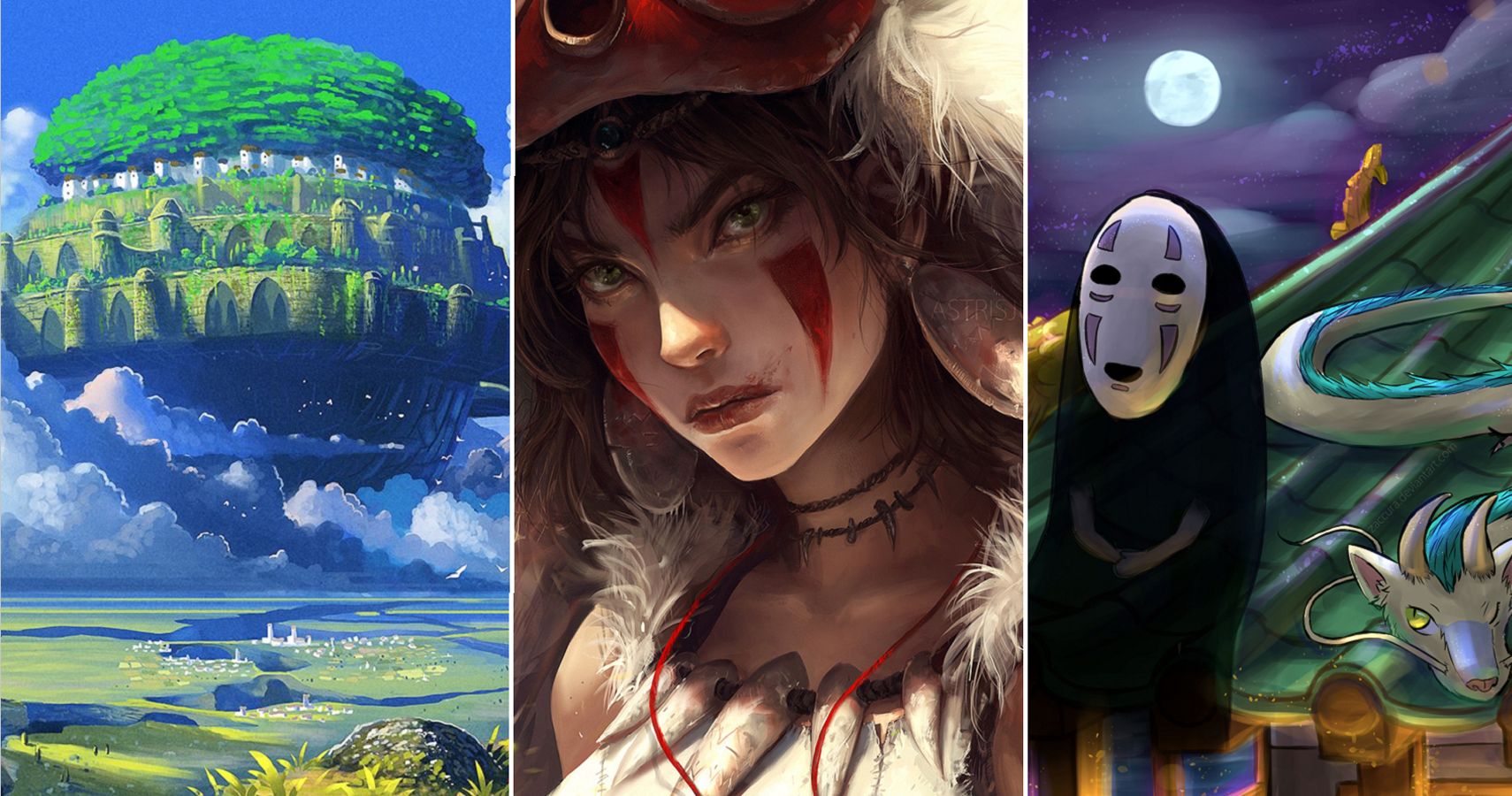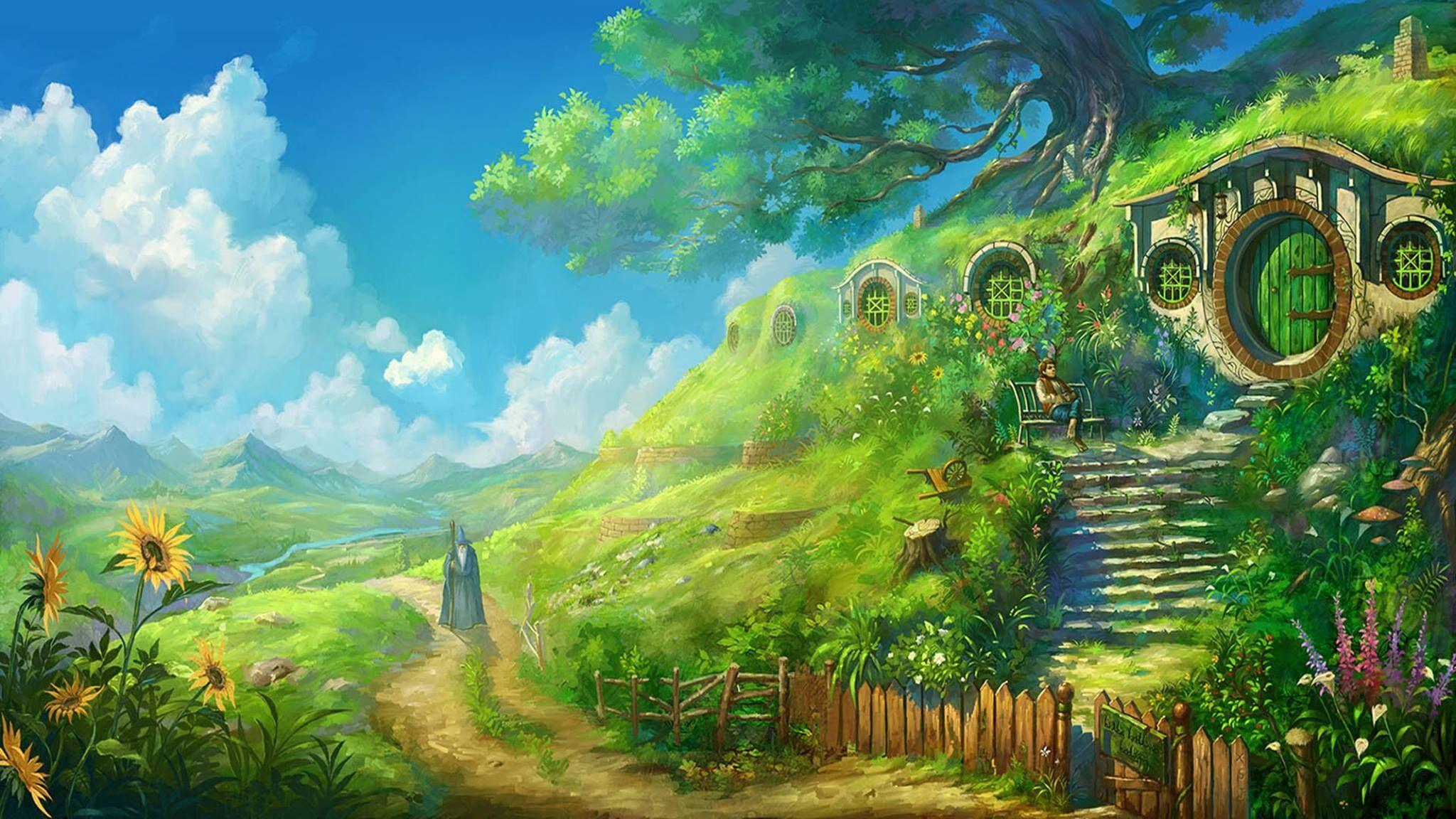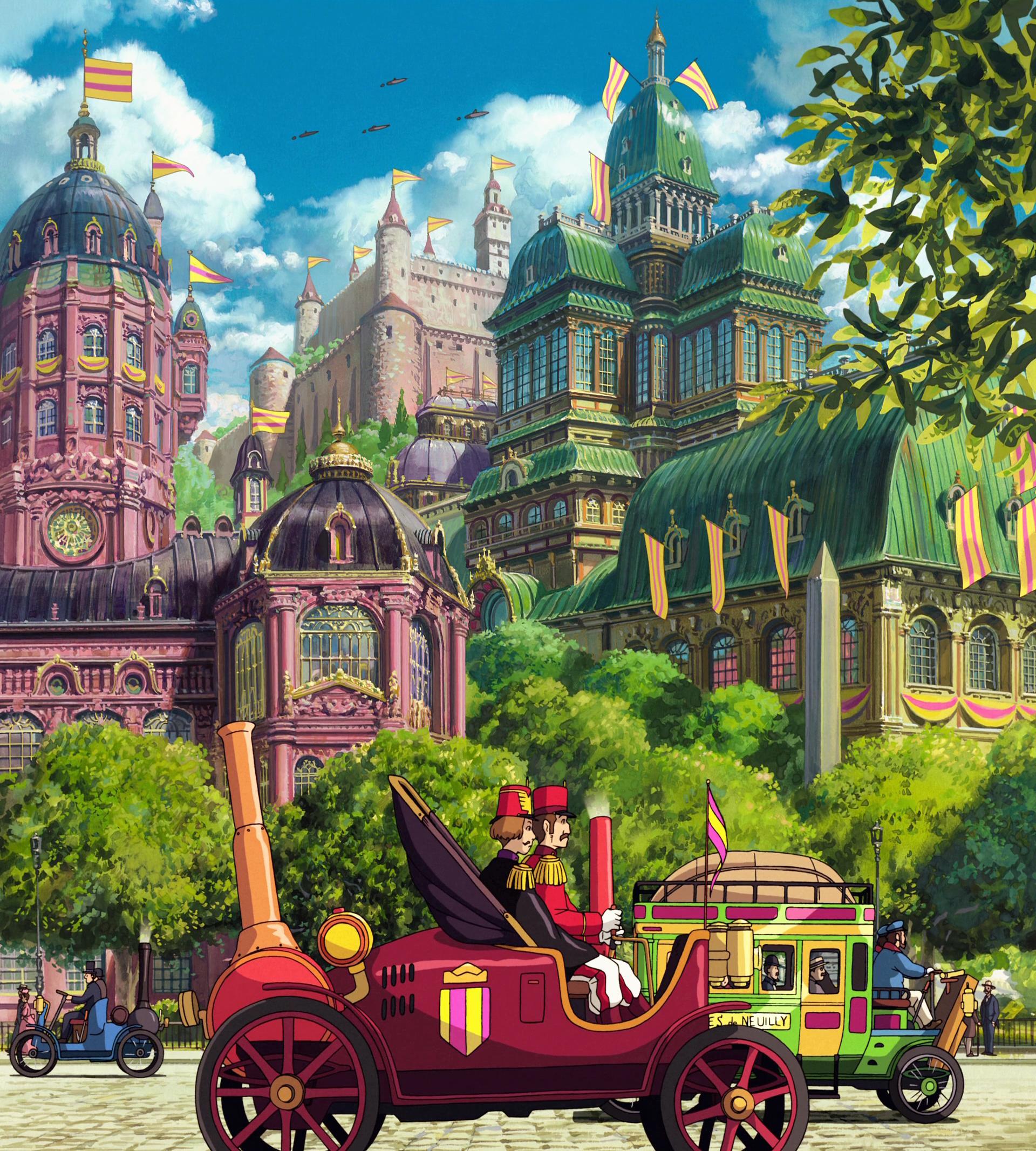Studio Ghibli Art - A Look Inside Its Visual Heart
There is something truly unique about the visual language found in the films from Studio Ghibli. It is a way of seeing the world, a distinct artistic approach that, well, just feels different. Many people find themselves drawn into these animated stories, not just by the characters or the plots, but by the sheer beauty of what they see on screen. It is almost as if each frame tells its own quiet story, filled with delicate details and a sense of wonder.
This particular style, you know, it has a way of sticking with you long after the credits roll. It is more than just pretty pictures; it is a whole mood, a feeling that wraps around you. From the gentle sway of trees in a breeze to the bustling energy of a marketplace, every visual element works together to build a sense of place that feels incredibly lived-in. It is rather like stepping into another reality, where even the simplest things hold a certain magic.
So, what exactly is it about this visual approach that makes it so compelling for so many? It is a question many folks ask, trying to put their finger on that special something. It is quite possibly the careful attention paid to the smallest parts, or perhaps the way big feelings are shown through subtle visual cues. We are going to take a closer look at what gives Studio Ghibli its truly remarkable visual identity, and maybe, just maybe, figure out some of the secrets behind its enduring charm.
Table of Contents
- What Makes Studio Ghibli Art So Special?
- How Does Studio Ghibli Art Bring Worlds to Life?
- The Magic of Color and Light in Studio Ghibli Art
- Why Does Studio Ghibli Art Feel So Real?
- The Human Touch - Character Design in Studio Ghibli Art
- Where Do Studio Ghibli Art Ideas Come From?
- Studio Ghibli Art - Its Lasting Impression
What Makes Studio Ghibli Art So Special?
When you first encounter a Studio Ghibli film, one of the first things that truly hits you is the look of it all. It is not like other animated pictures you might have seen, you know? There is a certain softness, a kind of warmth that comes through the drawings themselves. It is very much about the hand-drawn feel, the lines that look like they were put there by a person, with all the slight imperfections that make things feel real and heartfelt. This particular approach gives every scene a unique texture, almost like a painting that moves.
This commitment to a more traditional way of creating images is a big part of what makes the studio ghibli art stand out. They have always chosen to keep a lot of the work done by hand, even as computer graphics became more common in other places. This means that every tree, every cloud, every single blade of grass has been given individual care and attention. You can, in a way, feel the effort and the thought that went into crafting each little bit. It is a slow process, certainly, but the result is something that feels deeply personal and truly special.
Beyond just the drawing style, there is a deep connection to the natural world in much of the studio ghibli art. Forests are not just green backdrops; they are living, breathing places, full of secrets and ancient spirits. Water moves with a believable flow, whether it is a quiet stream or a vast ocean. The way light filters through leaves, or how shadows stretch long in the late afternoon, is always shown with such a gentle touch. This focus on nature is more than just pretty scenery; it is often a character in itself, shaping the feelings and experiences of those who live within these animated worlds, you see.
The visual storytelling is also a key element. It is not just about showing what is happening, but about showing how characters feel, or what a place means, without needing a lot of words. A slight change in the color of the sky, a particular way a character holds their body, or even the small items scattered around a room can tell you so much. This kind of visual communication is, well, pretty powerful. It allows the audience to connect with the story on a deeper, more emotional level, almost as if they are discovering things for themselves rather than being told them directly. It truly is a remarkable thing to witness, really.
How Does Studio Ghibli Art Bring Worlds to Life?
The way Studio Ghibli art creates these incredibly believable worlds is quite something, honestly. It often starts with the backgrounds, which are not just static pictures behind the action. They are full of life, full of tiny details that make them feel like places you could actually visit. Think about the bustling streets of a town or the quiet, overgrown paths in a forest. Every single element, from the texture of stone walls to the way laundry hangs on a line, is given such careful thought. It is almost like a window into another place, isn't it?
The artists spend a lot of time making sure these settings feel real, even when they are fantastical. They study real-world locations, taking in the way light falls, the way buildings are put together, or the way plants grow. This research then feeds into their drawings, giving them a sense of weight and truth. So, when you see a character walking through a field, you can almost feel the breeze and smell the grass, because the studio ghibli art has captured those sensations so well. It is a very immersive experience, you know.
Then there is the movement. The animation itself has a fluidity, a kind of natural flow that makes everything feel alive. Characters move with weight and purpose, and even subtle gestures convey a lot of feeling. When a character sighs, you really feel it. When they run, you sense their speed and effort. This attention to how things move, how they react to their surroundings, adds another layer of realism to the fantastical elements. It is not just about making things look pretty; it is about making them feel authentic, too, which is pretty clever.
And let's not forget the sense of atmosphere. The studio ghibli art has a way of creating a distinct mood for every scene. Sometimes it is peaceful and calm, with soft light and gentle colors. Other times, it is tense and dramatic, with sharper angles and darker tones. This feeling is built up through a combination of the background art, the character's expressions, and the overall pace of the animation. It is like the whole picture is breathing, pulling you deeper into its story, which is, you know, truly remarkable to experience.
The Magic of Color and Light in Studio Ghibli Art
The way Studio Ghibli uses color and light is, well, pretty much a masterclass in visual storytelling. They do not just pick colors that look nice; every hue and shade serves a purpose, helping to set the mood, show emotions, or even hint at what is to come. You will often notice how colors can shift dramatically from one scene to the next, reflecting a change in feeling or circumstance. It is a very deliberate choice, you see, and it adds so much to the overall impact of the studio ghibli art.
Think about the soft, warm glow of a morning sun in one of their films, or the cool, deep blues of a moonlit night. These choices are not accidental. They are carefully planned to make you feel a certain way. Warm colors might suggest comfort and safety, while cooler tones could bring a sense of mystery or sadness. This thoughtful use of the color palette helps to guide your feelings as you watch, drawing you deeper into the story without you even fully realizing it. It is, in a way, a silent language all its own.
Light, too, plays a massive role in the studio ghibli art. It is not just there to illuminate the scene; it is often a character in itself. Sunlight streaming through a window, the flickering glow of a fire, or the eerie light of a magical creature – each type of light has its own personality and meaning. The artists are incredibly skilled at showing how light interacts with surfaces, how it casts shadows, and how it can change the entire feel of a space. This attention to light makes the animated worlds feel incredibly real and tangible, almost like you could reach out and touch them.
Sometimes, the light can even feel symbolic. A single ray of light breaking through dark clouds might represent hope, or a sudden burst of brightness could signal a moment of revelation. This subtle yet powerful use of light adds layers of meaning to the visual experience. It is a very sophisticated way of communicating, allowing the visuals to carry a significant part of the narrative weight. It is, you know, truly captivating to see how they manage to do this so consistently across their films.
Why Does Studio Ghibli Art Feel So Real?
It is a question many people ponder: why do the worlds in Studio Ghibli films feel so incredibly real, even when they feature talking cats or spirits living in trees? Part of it comes down to the way the studio ghibli art pays attention to everyday life. They often show characters doing ordinary things, like cooking a meal, cleaning a house, or simply walking through a neighborhood. These small, quiet moments are given just as much care as the big, exciting ones, which helps to ground the fantastical elements in a believable reality. It is a rather clever trick, if you think about it.
This focus on the mundane, on the small acts that make up daily existence, makes the characters and their surroundings feel more relatable. You see them doing things you might do yourself, and that creates a connection. Even when a giant, furry creature is involved, the human characters are still dealing with things like school, family, or finding a job. This blend of the ordinary with the extraordinary is a hallmark of the studio ghibli art, and it is a big reason why their stories resonate so deeply with people from all walks of life. It is almost like looking into a neighbor's window, in a way.
Another aspect is the emotional honesty present in the visuals. Characters are allowed to feel a wide range of emotions, from pure joy to deep sadness, and these feelings are shown clearly on their faces and through their body language. There is no holding back, no sugar-coating. This openness about human experience makes the characters feel like genuine individuals, rather than just drawings. The art itself seems to convey empathy, making you feel what the characters are feeling, which is, you know, a very powerful thing.
The sound design, while not strictly visual, works hand-in-hand with the studio ghibli art to build this sense of reality. The rustle of leaves, the distant sound of a train, the sizzle of food cooking – these auditory details combine with the visuals to create a full sensory experience. It is a complete package, really, where every element supports the others to build a world that feels coherent and alive. This holistic approach to creation is a big part of why their films feel so much like living, breathing experiences, too.
The Human Touch - Character Design in Studio Ghibli Art
The characters in Studio Ghibli films are, in some respects, just as memorable as the worlds they inhabit. The studio ghibli art style for characters is often quite distinct. They are not always conventionally beautiful or heroic; sometimes they are a bit quirky, or even plain-looking. This approach makes them feel more like real people you might meet, with their own unique quirks and expressions. It is a very human way of drawing, you know, showing a wide range of appearances.
Their faces, in particular, are incredibly expressive. A slight tilt of the head, a subtle shift in the eyes, or a small frown can convey a wealth of feeling without a single word being spoken. This emphasis on subtle expressions allows for a deeper emotional connection with the characters. You can read their thoughts and feelings just by looking at them, which is a testament to the skill of the artists. It is almost like looking at a person you know well, seeing their emotions clearly.
The way characters move also tells a story. Their gestures, their posture, and even the way their clothes ripple in the wind are all carefully animated to reflect their personality and emotional state. A shy character might move with hesitant steps, while a confident one might stride boldly. These small details add so much to the believability of the characters, making them feel like more than just drawings on a screen. The studio ghibli art makes sure every bit of movement counts, which is really quite something.
Even the fantastical creatures and spirits in these films have a kind of human touch to their design. They might be strange or otherworldly, but they often possess relatable emotions or behaviors. This makes them feel less like monsters and more like beings with their own inner lives and motivations. It is a very clever way to make the unbelievable feel believable, tying even the most imaginative creations back to something we can all understand. This approach to character creation is a big reason why the studio ghibli art has such a lasting impact, really.
Where Do Studio Ghibli Art Ideas Come From?
You might wonder where all these amazing ideas for studio ghibli art come from. A lot of it, it seems, springs from a deep appreciation for Japanese folklore and traditional stories. Many of the spirits, creatures, and even some of the themes found in their films have roots in ancient tales and beliefs. This connection to a rich cultural heritage gives the art a timeless quality, making it feel both familiar and wonderfully new at the same time. It is a very special blend, in some respects.
Beyond folklore, a great deal of inspiration comes from a keen observation of the real world. The artists are known for taking extensive research trips, sketching everything from old buildings to natural landscapes. They pay attention to the way light falls on different surfaces, the specific shapes of trees, or the way people go about their daily lives. This careful observation helps to ground even the most fantastical elements in a sense of reality, making the animated worlds feel lived-in and authentic. It is almost like they are capturing moments from life itself, you know.
Personal experiences and memories also play a significant role. The creators often weave in elements from their own childhoods, their feelings about nature, or their thoughts on society. This personal touch gives the studio ghibli art a genuine, heartfelt quality that resonates deeply with audiences. It is not just about making a film; it is about sharing a piece of themselves through the visuals, which is pretty powerful. This kind of artistic honesty is a big part of what makes their work so compelling, too.
And then there is the sheer imagination, of course. While drawing from tradition and reality, the artists are also incredibly skilled at dreaming up entirely new concepts. They combine familiar elements in unexpected ways, creating creatures and settings that are truly unique. This blend of the known with the wonderfully unknown is a hallmark of the studio ghibli art, keeping viewers captivated and always a little surprised. It is, you know, a very creative process that never stops exploring new possibilities.
Studio Ghibli Art - Its Lasting Impression
The visual impact of Studio Ghibli art goes well beyond the screen. It has, in a way, left a deep mark on animation, on storytelling, and on the hearts of countless people around the globe. This distinctive visual style has shown what is possible when artists pour their hearts into every single frame, proving that traditional animation can stand tall and proud in a world that often rushes towards newer technologies. It is a very strong statement, really, about the power of hand-drawn pictures.
Many artists and animators, both new and experienced, look to the studio ghibli art for inspiration. They study the way colors are used, the way characters move, and the way worlds are built, trying to learn from its enduring appeal. The influence can be seen in various forms of media, from other animated films to video games and illustrations. It has set a kind of benchmark for visual quality and emotional depth in animation, which is, you know, quite a significant achievement.
Beyond the professional world, the studio ghibli art has created a unique visual language that many people recognize instantly. The image of Totoro standing in the rain, or the moving castle striding across the landscape, are pictures that have become iconic. These images evoke feelings of wonder, nostalgia, and a gentle understanding of the world. They are more than just scenes from movies; they are symbols of a particular kind of magic that resonates deeply with

Studio Ghibli: 10 Amazing Works Of Fan Art That We Love

Studio Ghibli Art Wallpapers - Top Free Studio Ghibli Art Backgrounds

Studio Ghibli Art Wallpapers - Top Free Studio Ghibli Art Backgrounds